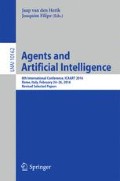Abstract
Multi-agent Plan Recognition (MPAR) infers teams and their goals from observed actions of individual agents. The complexity of creating a priori plan libraries significantly increases to account for diversity of action sequences different team structures may exhibit. A key challenge in MPAR is effectively pruning the joint search space of agent to team compositions and goal to team assignments. Here, we describe discrete Multi-agent Plan Recognition as Planning (MAPRAP), which extends Ramirez and Geffner’s Plan Recognition as Planning (PRAP) approach to multi-agent domains. Instead of a plan library, MAPRAP uses the planning domain and synthesizes plans to achieve hypothesized goals with additional constraints for suspected team composition and previous observations. By comparing costs of plans, MAPRAP identifies feasible interpretations that explain the teams and plans observed. We establish a performance profile for discrete MAPRAP in a multi-agent blocks-world domain. We evaluated precision, accuracy, and recall after each observation. We compare two pruning strategies to dampen the explosion of hypotheses tested. Aggressive pruning averages 1.05 plans synthesized per goal per time step for multi-agent scenarios vice 0.56 for single agent scenarios.
Access this chapter
Tax calculation will be finalised at checkout
Purchases are for personal use only
References
Sukthankar, G., Goldman, R.P., Geib, C., Pynadath, D.V., Bui, H.H.: Plan, Activity, and Intent Recognition Theory and Practice. Morgan Kaufmann, Burlington (2014)
Ramirez, M., Geffner, H.: Plan recognition as planning. In: Proceedings of the 21st International Joint Conference on Artificial Intelligence (2009)
Ramirez, M., Geffner, H.: Probabilistic plan recognition using off-the-shelf classical planners. In: Proceedings of the AAAI 2010 (2010)
Zhuo, H.H., Yang, Q., Kambhampati, S.: Action-model based multi-agent plan recognition. In: Advances in Neural Information Processing Systems 25 (2012)
Banerjee, B., Kraemer, L., Lyle, J.: Multi-agent plan recognition: formalization and algorithms. In: AAAI 2010 (2010)
Genersereth, M., Love, N.: General game playing: overview of the AAAI competition. AI Mag. 26(2), 62 (2005)
McDermott, D., AIPS-98 Planning Competition Committee: PDDL–the planning domain definition language (1998)
Kovacs, D.: A multi-agent extension of PDDL3.1. In: WS-IPC 2012, p. 19 (2012)
Muise, C., Lipovetzky, N., Ramirez, M.: MAP-LAPKT: omnipotent multi-agent planning via compilation to classical planning. In: Competition of Distributed and Multi-agent Planners (CoDMAP 2015) (2014)
Cohen, P.R., Perrault, C.R., Allen, J.F.: Beyond question answering. In: Strategies for Natural Language Processing, pp. 245–274. Hillsdale, NJ (1981)
Banerjee, B., Lyle, J., Kraemer, L.: New algorithms and hardness results for multi-agent plan recognition. In: AAAI 2011 (2011)
Sukthankar, G., Sycara, K.: Simultaneous team assignment and behavior recognition from spatio-temporal agent traces. In: Proceedings of the Twenty-First National Conference on Artificial Intelligence (AAAI 2006) (2006)
Intille, S.S., Bobick, A.F.: Recognizing planned, multi-person action. Comput. Vis. Image Underst. 81, 414–445 (2001)
Sadilek, A., Kautz, H.: Recognizing multi-agent activities from GPS data. In: Twenty-Fourth AAAI Conference on Artificial Intelligence (2010)
Sukthankar, G., Sycara, K.: Efficient plan recognition for dynamic multi-agent teams. In: Proceedings of 7th International Conference on Autonomous Agents and Multi-agent Systems (AAMAS 2008) (2008)
Pellier, D.: PDDL4J and GraphPlan open source implementation (2014). http://sourceforge.net/projects/pdd4j
“Bell Numbers” Wikipedia. The Free Encyclopedia. Wikimedia Foundation, Inc. (2014). https://en.wikipedia.org/wiki/Bell_number
Author information
Authors and Affiliations
Corresponding author
Editor information
Editors and Affiliations
Rights and permissions
Copyright information
© 2017 Springer International Publishing AG
About this paper
Cite this paper
Argenta, C., Doyle, J. (2017). Discrete Multi-agent Plan Recognition: Recognizing Teams, Goals, and Plans from Action Sequences. In: van den Herik, J., Filipe, J. (eds) Agents and Artificial Intelligence. ICAART 2016. Lecture Notes in Computer Science(), vol 10162. Springer, Cham. https://doi.org/10.1007/978-3-319-53354-4_12
Download citation
DOI: https://doi.org/10.1007/978-3-319-53354-4_12
Published:
Publisher Name: Springer, Cham
Print ISBN: 978-3-319-53353-7
Online ISBN: 978-3-319-53354-4
eBook Packages: Computer ScienceComputer Science (R0)

